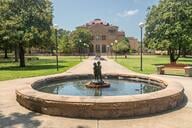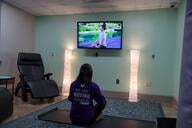You have /5 articles left.
Sign up for a free account or log in.
Governor Andrew M. Cuomo of New York drew widespread public attention last spring for his informative and straight-talking news conferences in the early days of the COVID-19 pandemic. While he holds fewer such events these days, the briefing he gave in New York City Tuesday showed that he can still hit a target -- which in this case was New York University and some of its partying students.
Colleges were front and center in Cuomo's statements about the coronavirus situation in his state, saying New York had a "problem" with outbreaks at colleges "all across the state … from Long Island all through upstate."
It's “common sense” that there would be significant numbers of cases on college campuses, given the priorities of many students, he said.
“I want to see my friends. I want to enjoy libations. We want to go to a bar. We want to go to a party … Those situations are increasing the spread.”
Cuomo singled out for scrutiny videotape of a group of New York University students partying in Washington Square Park, which is the core of NYU's sprawling urban campus. "Frankly, NYU security didn’t do anything about it. The local police didn’t do anything about it," Cuomo said.
NYU officials released a statement Tuesday after Cuomo's briefing saying the university "shares the governor's concerns" and that students who could be identified would be punished. But the statement also noted that NYU security officials do not have law enforcement powers and "have no jurisdiction on the streets of NYC or in Washington Square Park, which is a City public park."
The governor on Tuesday reiterated an announcement he made last month that campuses where more than 100 students got COVID-19 would have to switch to remote learning for two weeks. But the governor's office released no new details about those rules.
Another set of colleges and universities have altered previous plans for reopening their physical campuses.
Winona State University in Minnesota on Tuesday said it would self-quarantine students and employees for two weeks "in a concerted effort to slow the spread of COVID-19."
"Courses with face-to-face instruction will either shift entirely online, or if absolutely necessary, require increased precautions in order to continue in-person instruction," the announcement said. "All employees who do not need to be physically present on campus will shift to remote work, and individual campus facilities and other areas may impose additional restrictions as needed."
Winona State's latest update (which was Aug. 30) showed 97 cases and about 130 students quarantining, but the university said it was seeing an "increase in asymptomatic transmission" and that the increase affects "not only our campus, but the entire Winona community."
Bradley University, in Illinois, also announced an all-student quarantine for two weeks. The university said it had "just under 50 confirmed positive cases on the campus, which is comparable or even lower than some of our peer institutions," but it has more than 500 students in quarantine and more being picked up by contact tracing.
"This two-week quarantine creates an opportunity for us to reset our behaviors so we can have a successful semester," President Stephen Standifird said. "I still think it’s possible for us to do so. We would not engage in the two-week quarantine if I did not believe it was possible for us to complete the semester on campus successfully, but this only happens if we collectively change our behaviors moving forward."
Gettysburg College, which said late last month that it would restrict students to campus for two weeks in hopes of slowing the virus's spread, went a step further Friday, announcing that it would send all but first-year students and a cohort of other students home in an effort to "de-densify the campus."
President Robert Ioliano cited the Pennsylvania college's 64 cases over eight days as threatening to "outstrip our ability to house and quarantine students, as well as our contact-tracing capacity. We are beginning to see symptomatic students. Regrettably, we find ourselves on a path that is not sustainable, and it has caused us to come to the necessary but regrettable judgment that we needed to act before our overarching commitment to community well-being was compromised."
Ohio University also revised its approach, saying that rather than bring most students back to the Athens, Ohio, campus on Sept. 28, as planned, it would limit the number of students to about 7,200, or slightly less than a third of its total population of undergraduate and graduate students. Most courses will be online, even for those students who come to the physical campus.





